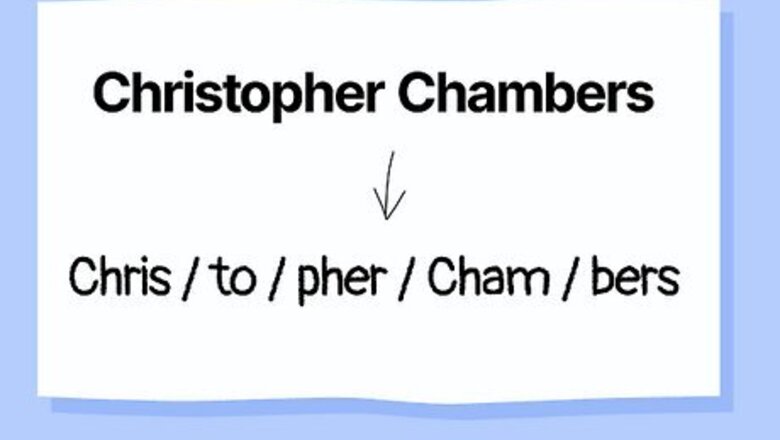
views
Identifying the Sounds in Your Name
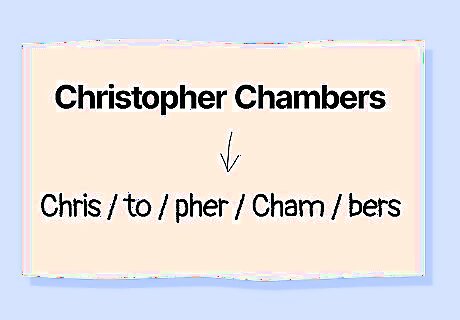
Break your name up into syllables. Hold your hand under your chin and say your name out loud. Count how many times your jaw drops and hits your hand. In most cases, this number is the amount of syllables in your name. For example, the name “Christopher Chambers” has five syllables total. Written out with a / denoting each break, this is what your name may look like after dividing into syllables: Chris / to / pher / Cham / bers.
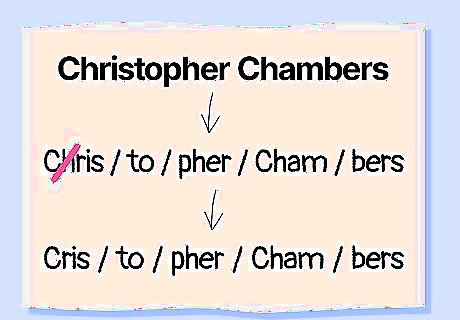
Identify the most important sounds in your name. Say your name out loud and consider what letters you’re actually pronouncing. Cross out any letters that you don’t hear when pronouncing your name. For example, the “h” in “Chris” doesn’t actually make a sound. If the name was spelled “Cris,” with no “h,” it’d be pronounced the same way. Rewrite your name with the unpronounced sounds removed. For “Christopher Chambers,” that may look something like this: Cris / to / pher / Cham / bers.
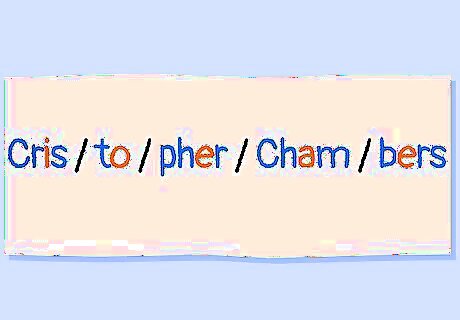
Mark which sounds are represented by consonants and vowels. Vowels are the English letters a, e, i, o, u and sometimes y. Consonants are all of the other letters in the alphabet. Looking at your name, separate the consonant and vowel sounds. For example: C r i s / t o / ph e r Ch a m / b e rs
Matching Each Sound to a Respelling Symbol
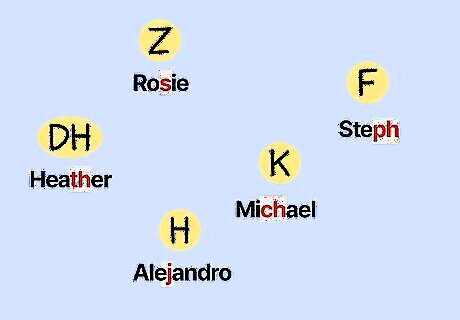
Consonants For each consonant sound in your name, find the letter symbol that would best help someone pronounce that sound. The letter symbol for a sound won’t always match the letter it’s written with in your actual name. For example, the ph in “Christopher” makes an “eff” sound, so it’s easier to write it’s pronunciation with the letter f. Look at the example names below to find the sounds that appear in your name, then take note of the indicated letter symbol. b ← Boris, Rob. ch ← Chase, Katrina. d ← Daphne, Fred. dh ← Heather. f ← Fanny, Steph. g ← Garret, Craig. h ← Hailey, Alejandro. j ← Georgia, Jenny. k ← Kate, Queenie, Michael. kh ← Jack, Frederick. l ← Laura, Adele. m ← Meg, Abraham. n ← Natasha, Dylan. ng ← Frank, Hank. ng-g ← Armstrong, Chang. p ← Posey, Spartacus, Chip. py ← Pugh. r ← Robert, Audrey. s (or) ss ← Sarah, Cynthia, Jesse. sh ← Shelly, Michelle, Alicia. t ← Thomas, Steph, Odette. th ← Thelma, Keith. v ← Velma, Silvia. w ← William, Anwar. wh ← Wiley, Whitney. y ← Yvonne. z ← Lorenzo, Rosie, Zach. zh ← Frazier.
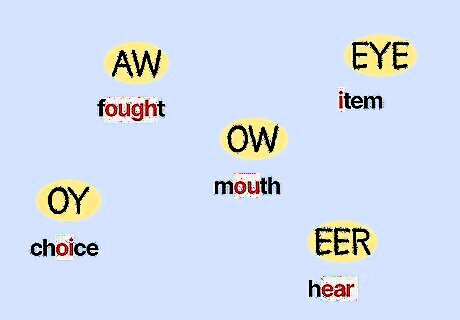
Vowels Match each vowel sound in your name to a visual letter symbol. Even if your name is spelled with the letter “o,” it may make more of an “uh” or “oo” sound. To phonetically spell your name so other people can easily say it, find the letter symbol that best represents the pronunciation of each vowel in your name. Compare each vowel in your name to the word examples given in the list below. When you find a matching one, take note of the indicated respelling symbol on the left. a ← clap, bat. ah (or) aa ← balm. air ← flare. ar ← cart. arr ← carry. aw ← fought, saw. ay, ai ← pace, ape. er ← better, Peter. e, eh ← dress, bet. ee ← geese, free. eer ← hear. err ← berry. ew ← ewe, few. eye ← item. i (or) ih ← fit, skin. Use “ih” at the end of a syllable, especially if the final “i” creates a real word like “hi” or “ski.” irr ← mirror. o ← lot. oh (or) oe ← coat, toe, go. oo ← food, root, shoe. ohr ← force, tore. or (or) awr ← north, war. orr ← orange. ou ← out. ow ← mouth. oy ← choice, boy. u ← rut. uu ← soot, put. uh ← brother, comma. ur ← nurse. urr ← hurry. ye ← price. yoor ← cure, Europe.

Other common sounds Some sounds appear frequently in common names and words. For that reason, they have commonly accepted respelling symbols that most English speakers will recognize and pronounce correctly. If any of the bolded letters below share a pronunciation with your name, copy the letters on the left of the arrow as a shortcut to writing your name phonetically. UR ← Bertha. AIR ← Farrah. EER ← Keira. OR ← Portia. AR ← Artie. IKE ← Mike. INE ← Adaline. ITE ← Dwight. ICE ← Rice. AL ← Callum. ALL ← Molly. AIL ← Abigail. ULL ← Joyful. OOL ← Kool. OAL ← Cole. EEL (or) EAL ← Seal. ILL ← Bill. ILE ← Kyle.
Writing the Phonetic Spelling of Your Name
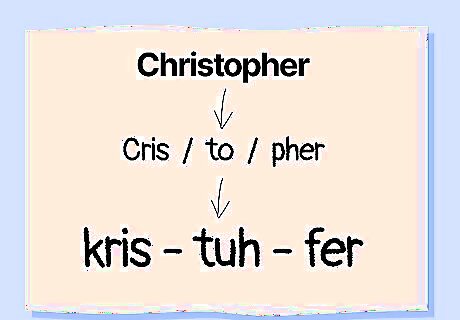
Write your name as it’s pronounced, not as it’s spelled. Put together all of the pronunciation symbols you found in the previous step to make the phonetic spelling of your name. Then, write a dash (-) between each syllable. For example, the first name “Christopher” is pronounced with the sounds “k,” “r,” “i,” “s,” “t,” “uh,” “f,” and “er” or “ur.” The rough phonetic spelling of Christopher would be “kris-tuh-fer” or “kris-tuh-fur.”
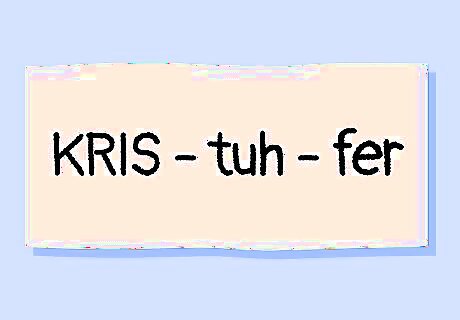
Capitalize the stressed syllables. Repeat your name out loud and try to identify which syllables jump out at you the most. These are often the syllables where your voice changes pitch or that take the longest to say. If you’re struggling to identify stressed syllables in your name, say your name in a sentence as if you’re introducing yourself. Speak slowly, enunciate, and listen again for which syllable you naturally place the emphasis on. The correctly formatted phonetic spelling of “Christopher” would be KRIS-tuh-fer. As another example, Wolfgang Amadeus Mozart would be phonetically spelled as VOOLF-gang Am-a-DE-us MOT-sart.

Read the phonetic spelling of your name out loud. Use the respelling symbols in Part 2 as a guide to phonetically spelling of your name. However, you can also rely on your own logic and common sense. If your goal is to get another human to read your phonetic spelling and pronounce your name correctly, put yourself in their shoes. Pretend you’ve never heard your name. Take a look at your phonetic spelling and consider whether any of those sounds or letters could cause confusion or be mispronounced. If you feel like the “correct” respelling symbol for a sound in your name doesn’t feel right, change it to something you would recognize as creating that sound!




















Comments
0 comment